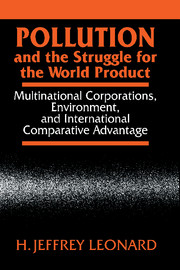 Pollution and the Struggle for the World Product
Pollution and the Struggle for the World Product Published online by Cambridge University Press: 05 January 2012
It is difficult from a methodological standpoint to assess whether environmental factors actually have, in the aggregate, induced U.S. manufacturing firms to select more foreign sites for branch plants and have increased the rate of industrialization in countries whose environmental factor endowment is still abundant. The logic of comparative advantage says that if all other things are equal and if environmental regulations significantly affect industry cost calculations, divergent national standards will promote a reshuffling of international industrial-location patterns. But pollution-control costs and other environmental concerns affecting industries cannot be examined in a vacuum. A number of factors make up total costs of production, and costs in turn may be only one of a number of tangible and intangible factors that determine where a company sets up productive facilities.
Consequently, this chapter seeks to establish some recent trends in foreign investment by U.S. industries that might coincide with those to be expected following the introduction of differential national environmental regulations in a Heckscher-Ohlin world. After outlining some of the factors that make it difficult to single out the effects of environmental regulations on comparative advantage in the real world, we shall employ a variety of methods to ascertain whether industries with high pollution-control costs in the United States have recently increased investments in countries with low environmental standards.
To save this book to your Kindle, first ensure [email protected] is added to your Approved Personal Document E-mail List under your Personal Document Settings on the Manage Your Content and Devices page of your Amazon account. Then enter the ‘name’ part of your Kindle email address below. Find out more about saving to your Kindle.
Note you can select to save to either the @free.kindle.com or @kindle.com variations. ‘@free.kindle.com’ emails are free but can only be saved to your device when it is connected to wi-fi. ‘@kindle.com’ emails can be delivered even when you are not connected to wi-fi, but note that service fees apply.
Find out more about the Kindle Personal Document Service.
To save content items to your account, please confirm that you agree to abide by our usage policies. If this is the first time you use this feature, you will be asked to authorise Cambridge Core to connect with your account. Find out more about saving content to Dropbox.
To save content items to your account, please confirm that you agree to abide by our usage policies. If this is the first time you use this feature, you will be asked to authorise Cambridge Core to connect with your account. Find out more about saving content to Google Drive.